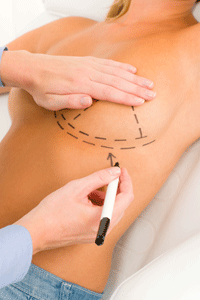 Breast Augmentation Recovery
Breast Augmentation Recovery
Breast augmentation is a surgical procedure that requires anesthesia, a doctor cutting into your body, and a pretty extensive recovery process. The overall recovery process after breast augmentation surgery depends on several factors. These include but are not limited to your body’s natural ability to heal, whether or not you experience complications, and the type of augmentation surgery that is performed. Here are a few things that you should be prepared for after your surgery.
Day 1
The first day after your operation, you will most likely be in a daze depending on how quickly your body processes pain medication and anesthesia. After the surgery, your breast area will be wrapped in gauze for several days. It is also possible that you will have to have a drainage tube in the incision for several days to allow any fluid buildup to be released. This tube is not permanent but you will likely have to return to the doctor to have the tube removed. However, you shouldn’t need to be put under anasthesia again for the removal process.
Week 1
Within the first week, it is very important that you take it easy and relax. Don’t lift heavy objects or bend over to pick up things off the floor. You can’t exercise during this time as you don’t want to risk reopening your incision. You will also likely need pain medications, even if you have a high pain tolerance. Most of the time, doctors will prescribe pain medications for the first week or so, depending on your history with pain meds. It is highly suggested that you limit the use of prescription pain meds as they are not only highly addictive but they can also make things like working and being productive more difficult due to side effects like drowsiness and fatigue. As soon as you can, switch to over the counter painkillers like acetaminophen which is found in Tylenol. After the first two or three days, this should be good enough to dull the pain while avoiding the drowsiness of stronger pain medicine.
Week 2
By the middle or end of the first week at the very latest, you should be able to start returning to your normal routine of things. Assuming there have been no complications, returning to work and normal life things such as going to the supermarket, and maybe even light housework. But it is important not to lift anything heavy. Keep it under 10 pounds but if you can avoid lifting anything at this point, that is your safest option.
Month 1
One month, you made it! By this time, most of the pain should be completely gone. Your incision should be healing up nicely though you will still see scars beginning to form. At this point, you can return to some of your fitness routines though it is still not advisable to run to the gym and start doing chest exercises. Ease your way back into your gym routine. Start with some cardio and lower body workouts. It is also recommended that by this point, you try doing some arm exercises like bicep curls to help improve blood circulation in your shoulders. Don’t start lifting extremely heavy weights at first though. Your incision might be completely closed but you could still risk tearing something open. It is better to take it slow and safe than to be sorry and have to go back to the doctor for another operation to close a reopened incision.
Week 6
Once you have reached week six weeks post operation, you should, at this point, be returning back to normal. But it is still important to remember to take things slow. You don’t want to jump into things too quickly and risk rupturing one of your implants. During week six, you can start lifting heavier objects. This includes performing upper body workouts. Remember: start slow and if you are feeling any pain at all, stop and try again in 2 weeks. If this pain continues after two months after your surgery, contact your surgeon immediately to make sure there aren’t any issues with the implants themselves.
Fully Healed?
After you have reached six weeks and beyond, if there are no serious complications, your body should be fully healed. You should be able to return to normal daily, work, and exercise routines. The healing process is quite long as you basically spend two months out of the year in recovery. That is assuming that there were no complications. The reality is that once you have committed to breast implants, this may become a regular thing for you. Statistically speaking, it may be six months, two years, or if you are lucky, ten years. But at some point, you are going to be faced with the reality that breast implants don’t come with a lifelong warranty.
What does this mean for you? It means that when your implant malfunctions, ruptures or springs a leak, you will have to go back under the blade to have another operation. At that point, you can choose to have them removed or replaced but another operation will be necessary. Breast augmentation surgery is not a “once-and-you’re-done” deal. It is a lifelong commitment unless you choose to have them removed. The frequency of these operations varies from person to person.
 There is another way!
There is another way!
If you are thinking that this sounds like a lot of work, that’s because it is. The constant maintenance and doctor visits to have them checked out alone is a hassle. Don’t get discouraged though, there are other options that can allow you to have the breasts you have always imagined. If you are interested in a way that doesn’t require surgery, look at a natural way for breast enhancements with Natureday. Many have been satisfied with the results of Natureday’s herbal supplements. Just check out some of their 2,600 testimonials.
If you’re interested in giving it a try or you are just curious about what it includes, here is a list of herbs we recommend for Natural Breast Enhancement: Cumin extract, wild yam, fennel, blessed thistle, and fenugreek.
2,600 Testimonials, pictures, and voice testimonials
to see pictures of male Breasts
